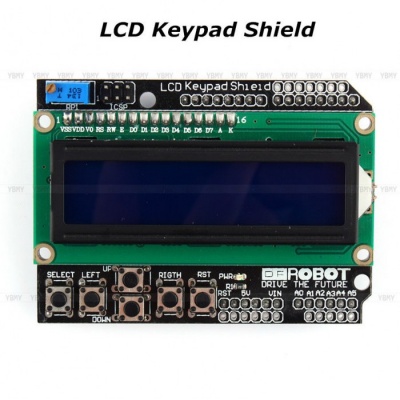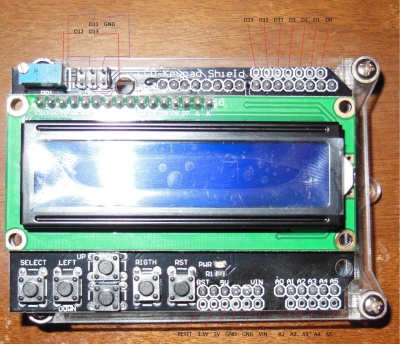Difference between revisions of "Arduino: LCD keypad shield"
Jump to navigation
Jump to search
Onnowpurbo (talk | contribs) |
Onnowpurbo (talk | contribs) |
||
| Line 2: | Line 2: | ||
[[File:FKUA4JDITKJE7UI.LARGE.jpg|center|400px|thumb]] | [[File:FKUA4JDITKJE7UI.LARGE.jpg|center|400px|thumb]] | ||
| + | |||
| + | |||
| + | ==Test Program== | ||
| + | |||
| + | //Sample using LiquidCrystal library | ||
| + | #include <LiquidCrystal.h> | ||
| + | |||
| + | /******************************************************* | ||
| + | |||
| + | This program will test the LCD panel and the buttons | ||
| + | Mark Bramwell, July 2010 | ||
| + | |||
| + | ********************************************************/ | ||
| + | |||
| + | // select the pins used on the LCD panel | ||
| + | LiquidCrystal lcd(8, 9, 4, 5, 6, 7); | ||
| + | |||
| + | // define some values used by the panel and buttons | ||
| + | int lcd_key = 0; | ||
| + | int adc_key_in = 0; | ||
| + | #define btnRIGHT 0 | ||
| + | #define btnUP 1 | ||
| + | #define btnDOWN 2 | ||
| + | #define btnLEFT 3 | ||
| + | #define btnSELECT 4 | ||
| + | #define btnNONE 5 | ||
| + | |||
| + | // read the buttons | ||
| + | int read_LCD_buttons() | ||
| + | { | ||
| + | adc_key_in = analogRead(0); // read the value from the sensor | ||
| + | // my buttons when read are centered at these valies: 0, 144, 329, 504, 741 | ||
| + | // we add approx 50 to those values and check to see if we are close | ||
| + | if (adc_key_in > 1000) return btnNONE; // We make this the 1st option for speed reasons since it will be the most likely result | ||
| + | // For V1.1 us this threshold | ||
| + | if (adc_key_in < 50) return btnRIGHT; | ||
| + | if (adc_key_in < 250) return btnUP; | ||
| + | if (adc_key_in < 450) return btnDOWN; | ||
| + | if (adc_key_in < 650) return btnLEFT; | ||
| + | if (adc_key_in < 850) return btnSELECT; | ||
| + | |||
| + | // For V1.0 comment the other threshold and use the one below: | ||
| + | /* | ||
| + | if (adc_key_in < 50) return btnRIGHT; | ||
| + | if (adc_key_in < 195) return btnUP; | ||
| + | if (adc_key_in < 380) return btnDOWN; | ||
| + | if (adc_key_in < 555) return btnLEFT; | ||
| + | if (adc_key_in < 790) return btnSELECT; | ||
| + | */ | ||
| + | |||
| + | |||
| + | return btnNONE; // when all others fail, return this... | ||
| + | } | ||
| + | |||
| + | void setup() | ||
| + | { | ||
| + | lcd.begin(16, 2); // start the library | ||
| + | lcd.setCursor(0,0); | ||
| + | lcd.print("Push the buttons"); // print a simple message | ||
| + | } | ||
| + | |||
| + | void loop() | ||
| + | { | ||
| + | lcd.setCursor(9,1); // move cursor to second line "1" and 9 spaces over | ||
| + | lcd.print(millis()/1000); // display seconds elapsed since power-up | ||
| + | |||
| + | |||
| + | lcd.setCursor(0,1); // move to the begining of the second line | ||
| + | lcd_key = read_LCD_buttons(); // read the buttons | ||
| + | |||
| + | switch (lcd_key) // depending on which button was pushed, we perform an action | ||
| + | { | ||
| + | case btnRIGHT: | ||
| + | { | ||
| + | lcd.print("RIGHT "); | ||
| + | break; | ||
| + | } | ||
| + | case btnLEFT: | ||
| + | { | ||
| + | lcd.print("LEFT "); | ||
| + | break; | ||
| + | } | ||
| + | case btnUP: | ||
| + | { | ||
| + | lcd.print("UP "); | ||
| + | break; | ||
| + | } | ||
| + | case btnDOWN: | ||
| + | { | ||
| + | lcd.print("DOWN "); | ||
| + | break; | ||
| + | } | ||
| + | case btnSELECT: | ||
| + | { | ||
| + | lcd.print("SELECT"); | ||
| + | break; | ||
| + | } | ||
| + | case btnNONE: | ||
| + | { | ||
| + | lcd.print("NONE "); | ||
| + | break; | ||
| + | } | ||
| + | } | ||
| + | } | ||
| + | |||
| + | |||
Revision as of 17:30, 3 February 2018
Test Program
//Sample using LiquidCrystal library
#include <LiquidCrystal.h>
/*******************************************************
This program will test the LCD panel and the buttons
Mark Bramwell, July 2010
********************************************************/
// select the pins used on the LCD panel
LiquidCrystal lcd(8, 9, 4, 5, 6, 7);
// define some values used by the panel and buttons
int lcd_key = 0;
int adc_key_in = 0;
#define btnRIGHT 0
#define btnUP 1
#define btnDOWN 2
#define btnLEFT 3
#define btnSELECT 4
#define btnNONE 5
// read the buttons
int read_LCD_buttons()
{
adc_key_in = analogRead(0); // read the value from the sensor
// my buttons when read are centered at these valies: 0, 144, 329, 504, 741
// we add approx 50 to those values and check to see if we are close
if (adc_key_in > 1000) return btnNONE; // We make this the 1st option for speed reasons since it will be the most likely result
// For V1.1 us this threshold
if (adc_key_in < 50) return btnRIGHT;
if (adc_key_in < 250) return btnUP;
if (adc_key_in < 450) return btnDOWN;
if (adc_key_in < 650) return btnLEFT;
if (adc_key_in < 850) return btnSELECT;
// For V1.0 comment the other threshold and use the one below:
/*
if (adc_key_in < 50) return btnRIGHT;
if (adc_key_in < 195) return btnUP;
if (adc_key_in < 380) return btnDOWN;
if (adc_key_in < 555) return btnLEFT;
if (adc_key_in < 790) return btnSELECT;
*/
return btnNONE; // when all others fail, return this...
}
void setup()
{
lcd.begin(16, 2); // start the library
lcd.setCursor(0,0);
lcd.print("Push the buttons"); // print a simple message
}
void loop()
{
lcd.setCursor(9,1); // move cursor to second line "1" and 9 spaces over
lcd.print(millis()/1000); // display seconds elapsed since power-up
lcd.setCursor(0,1); // move to the begining of the second line
lcd_key = read_LCD_buttons(); // read the buttons
switch (lcd_key) // depending on which button was pushed, we perform an action
{
case btnRIGHT:
{
lcd.print("RIGHT ");
break;
}
case btnLEFT:
{
lcd.print("LEFT ");
break;
}
case btnUP:
{
lcd.print("UP ");
break;
}
case btnDOWN:
{
lcd.print("DOWN ");
break;
}
case btnSELECT:
{
lcd.print("SELECT");
break;
}
case btnNONE:
{
lcd.print("NONE ");
break;
}
}
}
Referensi
- https://github.com/andygock/DFR_LCD_Keypad/archive/master.zip
- https://www.dfrobot.com/wiki/index.php/Arduino_LCD_KeyPad_Shield_(SKU:_DFR0009)

